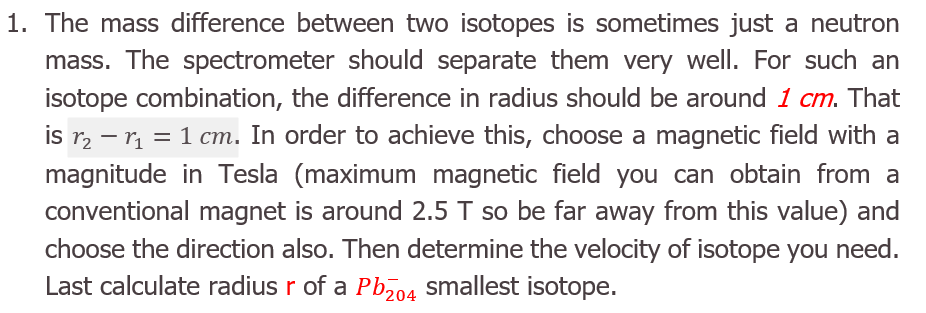The mass difference between two isotopes is sometimes just a neutron mass. The spectrometer should separate them very well. For such an isotope combination, the difference in radius should be around 1 cm. That is r2 – r = 1 cm. In order to achieve this, choose a magnetic field with a magnitude in Tesla (maximum magnetic field you can obtain from a conventional magnet is around 2.5 T so be far away from this value) and choose the direction also. Then determine the velocity of isotope you need. Last calculate radius r of a Pbz04 smallest isotope.
The mass difference between two isotopes is sometimes just a neutron mass. The spectrometer should separate them very well. For such an isotope combination, the difference in radius should be around 1 cm. That is r2 – r = 1 cm. In order to achieve this, choose a magnetic field with a magnitude in Tesla (maximum magnetic field you can obtain from a conventional magnet is around 2.5 T so be far away from this value) and choose the direction also. Then determine the velocity of isotope you need. Last calculate radius r of a Pbz04 smallest isotope.
Related questions
Question
According to this question; in order to produce this magnetic field, determine the current and number of turns, radius and other parameters of a solenoid that we need. Also can you show how you will position this solenoid?

Transcribed Image Text:The mass difference between two isotopes is sometimes just a neutron
mass. The spectrometer should separate them very well. For such an
isotope combination, the difference in radius should be around 1 cm. That
is r2 – r = 1 cm. In order to achieve this, choose a magnetic field with a
magnitude in Tesla (maximum magnetic field you can obtain from a
conventional magnet is around 2.5 T so be far away from this value) and
choose the direction also. Then determine the velocity of isotope you need.
Last calculate radius r of a Pbz04 smallest isotope.
Expert Solution
This question has been solved!
Explore an expertly crafted, step-by-step solution for a thorough understanding of key concepts.
Step by step
Solved in 6 steps with 5 images
